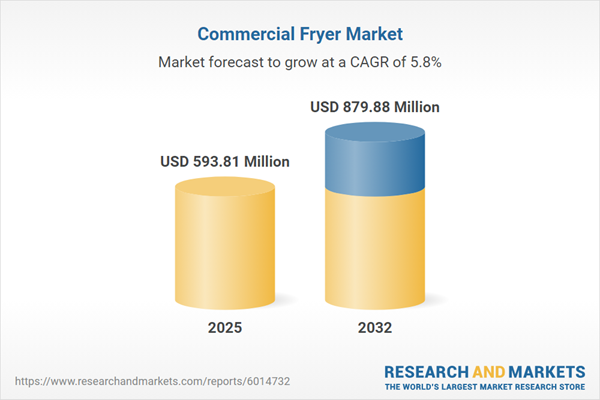Speak directly to the analyst to clarify any post sales queries you may have.
The commercial fryer market is rapidly transforming as technological advances, sustainability imperatives, and shifting consumer preferences drive new opportunities for foodservice operators and equipment manufacturers. Leaders seeking actionable insights need a clear understanding of these market forces to inform investment, procurement, and strategic planning.
Market Snapshot: Commercial Fryer Market Growth and Opportunities
The commercial fryer market grew from USD 561.63 million in 2024 to USD 593.81 million in 2025, driven by steady demand across foodservice segments. With an expected CAGR of 5.77%, the market is forecast to reach USD 879.88 million by 2032. The expansion reflects increased adoption of energy-efficient technologies, advanced monitoring systems, and greater focus on equipment reliability. Growth is supported by evolving menu trends, operational pressures, and regulatory mandates across global regions.
Scope & Segmentation
This research delivers a comprehensive segmentation and analysis of the commercial fryer market, offering precise insights for targeted business strategies:
- Product Types: Countertop, Drop In, Filtered, Floor Standing, Split Pot
- Fuel Types: Dual Fuel, Electric (Single Phase, Three Phase), Gas (Natural Gas, Propane)
- Applications: Cafeterias, Full Service Restaurants (Casual Dining, Fine Dining), Hotels & Accommodations, Institutional Kitchens, Quick Service Restaurants (Burgers, Fried Chicken)
- End User Segments: Catering Services, Food Trucks & Carts, Hotels & Resorts, Institutional Facilities, Restaurants
- Sales Channels: Aftermarket, Direct Sales, Distributor, Online Retail
- Regions: Americas (North America: United States, Canada, Mexico; Latin America: Brazil, Argentina, Chile, Colombia, Peru), Europe, Middle East & Africa (Europe: United Kingdom, Germany, France, Russia, Italy, Spain, Netherlands, Sweden, Poland, Switzerland; Middle East: United Arab Emirates, Saudi Arabia, Qatar, Turkey, Israel; Africa: South Africa, Nigeria, Egypt, Kenya), Asia-Pacific (China, India, Japan, Australia, South Korea, Indonesia, Thailand, Malaysia, Singapore, Taiwan)
- Leading Companies Analyzed: The Middleby Corporation, Welbilt Inc., Illinois Tool Works Inc., Henny Penny Corporation, MKN Maschinenfabrik Kurt Neubauer GmbH & Co. KG, Fagor Industrial S. Coop., Electrolux Professional AB, Lincat Group plc
This segmentation enables decision-makers to match equipment capabilities, fuel systems, and distribution strategies with targeted operational requirements and regional demands.
Key Takeaways for Senior Decision-Makers
- Advanced oil filtration, temperature control, and integrated safety features enhance performance, meeting regulatory and operational needs.
- Growing emphasis on digital monitoring and analytics empowers predictive maintenance and real-time resource optimization in foodservice environments.
- Demand for sustainable, energy-efficient fryers is accelerating, with manufacturers innovating on fuel flexibility and eco-friendly materials.
- Adoption of modular, scalable fryers supports diverse kitchen sizes and menu changes, improving workflow efficiency and throughput.
- Aftermarket support with localized service and rapid parts availability is becoming central to operational resilience and long-term value.
- Procurement strategies are increasingly shaped by regional regulatory standards, energy costs, and consumer-driven menu innovation, requiring adaptable solutions.
Tariff Impact: Realignment Under U.S. Trade Policy
Recent and upcoming U.S. tariff adjustments are prompting manufacturers to reassess their supply chains, with some shifting production or sourcing strategies to mitigate heightened duties. This realignment introduces cost pressures and potential lead-time fluctuations for both distributors and end-users. Domestic producers may benefit from reduced foreign competition; however, navigating changing supply relationships and integrating tariff considerations into capital planning will be vital for operators investing in new or retrofit fryer systems. The trend is also fostering stronger local service networks for ongoing equipment support.
Methodology & Data Sources
The report is grounded in a multi-stage methodology, including in-depth interviews with industry executives, thorough technical literature reviews, and analysis of regulatory filings. Data validity is reinforced through triangulation with public disclosures and local market panel insights, ensuring robust, actionable findings for all commercial fryer stakeholders.
Why This Report Matters
- Enables informed procurement and capital allocation by mapping market dynamics and technology adoption patterns across regions.
- Supports strategic planning for resilience amid regulatory, economic, and supply chain shifts influencing the commercial fryer industry.
- Guides investment in innovative, sustainable, and future-ready equipment features that align with evolving operational and culinary demands.
Conclusion
This market assessment provides a data-driven foundation for understanding and navigating the evolving commercial fryer sector. Senior decision-makers can apply these insights to seize new growth opportunities, enhance operational efficiency, and sustain competitive advantage.
Additional Product Information:
- Purchase of this report includes 1 year online access with quarterly updates.
- This report can be updated on request. Please contact our Customer Experience team using the Ask a Question widget on our website.
Table of Contents
3. Executive Summary
4. Market Overview
7. Cumulative Impact of Artificial Intelligence 2025
Companies Mentioned
The companies profiled in this Commercial Fryer market report include:- The Middleby Corporation
- Welbilt Inc.
- Illinois Tool Works Inc.
- Henny Penny Corporation
- MKN Maschinenfabrik Kurt Neubauer GmbH & Co. KG
- Fagor Industrial S. Coop.
- Electrolux Professional AB
- Lincat Group plc
Table Information
| Report Attribute | Details |
|---|---|
| No. of Pages | 199 |
| Published | October 2025 |
| Forecast Period | 2025 - 2032 |
| Estimated Market Value ( USD | $ 593.81 Million |
| Forecasted Market Value ( USD | $ 879.88 Million |
| Compound Annual Growth Rate | 5.7% |
| Regions Covered | Global |
| No. of Companies Mentioned | 9 |









